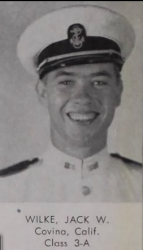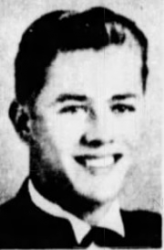
 |
|
|
||
|
JACK WINTON WILKE |
||||
|
Engagements: • World War II (1941 - 1945) |
||||
| Biography: | ||||
|
Jack Winton Wilke Ensign, US Naval Reserve Navy Cross & Purple Heart Joseph Henry Wilke and Helen Dorothy Fischer were married in Santa Ana, Orange, CA on 12 Aug 1913. They were the parents of two children; Helen Kathleen Hege and Jack Winton Wilke.Jack enlisted in the US Naval Reserve aviation candidate program (V-5) as a Seaman 2/c (NSN:413 22 92) on 13 January 1941 in Long Beach, CA. He reported to Naval Reserve Aviation Base, Long Beach, CA. for Elimination Flight training. He successfully completed that training on 17 Jan 1941 and was transferred to NAS, Corpus Christi, Tex. He became an aviation cadet on 15 Mar 1941. After successfully completing Primary, Intermediate and Advanced Squadron training he was designated a naval aviator and, he was commissioned an Ensign on 30 August 1941. On 8 Dec 1941 Ens Wilke reported as a passenger to the USS Harris (AP-8) in San Diego. He was transported from San Diego to Pearl Harbor under orders to report to Patrol Squadron Twenty-Four (PATRON-24). In late May 1942, while attached to VP-24, Ens. Wilke volunteered to provide pathfinder (Navigation) services for a USS Hornet (CV-8) based Torpedo Squadron Eight (VT-8) detachment of six new TBF-1 aircraft flown from Hawaii to NAS Midway on 01 Jun 1942 to augment the island's defenses. It was a flight of 1200 miles across open ocean. The six planes arrived later that day at Midway after a flight without incident and without ship or PBY support. In the early morning hours of 4 June, he volunteered again to perform navigation and Radioman/Bombardier duties for this same detachment of VT-8 as it flew into battle against the numerically superior Japanese forces. First to attack the Japanese Striking Force carriers and without friendly fighter support, the torpedo planes were overwhelmed by Japanese fighters. However, they pressed forward in the face of withering fire. Five of the six planes did not return to Midway. Ens Wilke, Lt Langdon Fieberling (pilot) and their radioman/gunner, RM2 Raymond Osborn were killed in action. Their remains were unrecoverable. Ens. Wilke was missing in action on 4 Jun 1942 and presumed dead on 5 Jun 1943. Ens. Wilke was (posthumously) awarded the Navy Cross, Purple Heart, Presidential Unit Citation, American Defense Medal, American Campaign Medal, Asiatic-Pacific Campaign Medal with one battle star, and the World War II Victory Medal. The destroyer escort, USS Jack W. Wilke (DE-800), was named in his honor. She was launched by Consolidated Steel Corp., Orange, Tex., 18 December 1943; sponsored by Mrs. Joe H. Wilke, mother of Ens. Wilke; and commissioned 7 March 1944, Lt. Comdr. Robert D. Lowther in command. The Wilke served in the Atlantic Theater of operations during 1944-1945. The ship was decommissioned 24 May 1960, and entered the Atlantic Reserve Fleet at Philadelphia. She was struck from the Navy list on 1 August 1972 and later sold for scrap to Union Metals & Alloys Corp., New York, on 4 March 1974. -------------------------------- Navy Cross Citation: The President of the United States takes pride in presenting the Navy Cross (Posthumously) to Jack W., Ensign, U.S. Naval (Reserve), for extraordinary heroism in operations against the enemy while serving as Radioman/Bombardier of a carrier-based Navy Torpedo Plane in Torpedo Squadron EIGHT, embarked from Naval Air Station Midway during the "Air Battle of Midway," against enemy Japanese forces on 4 and 5 June 1942. In the first attack against an enemy carrier of the Japanese invasion fleet, Ensign Wilke pressed home his attack in the face of withering fire from enemy Japanese fighters and anti-aircraft forces. Because of events attendant upon the Battle of Midway, there can be no doubt that he gallantly gave up his life in the service of his country. His courage and utter disregard for his own personal safety were in keeping with the highest traditions of the United States Naval Service. He gallantly gave his life for his country. Bureau of Naval Personnel Information Bulletin No. 310 (January 1943) --------------------------------- The Presidential Unit Citation awarded to Torpedo Squadron Eight (VT-8) reads: For extremely heroic and courageous performance in combat during the “Air Battle of Midway,” June 4, 1942. Flying low without fighter support, Torpedo Squadron EIGHT began the perilous mission, Intercept and attack! First to sight the enemy, the squadron attacked with full striking power against crushing enemy opposition, scoring torpedo hits on Japanese forces. Realizing to a man that insufficient fuel would prevent a return to the carrier, the pilots held doggedly to the target, dropping torpedoes at point-blank range in the face of blasting antiaircraft fire that sent the planes one by one, hurtling aflame in the sea. The loss of 29 lives, typifying valor, loyalty, and determination, was the price paid for Torpedo Squadron EIGHTs vital contribution to the eventual success of our forces in this epic battle of the air. ---------------------------------- The family of Ens. Wilke received a Presidential Commemoration. It reads: In grateful memory of Jack Winton Wilke, who died in the service of his country, SEA, Pacific Area, MIDWAY, 5 JUNE 1943 (Presumed)*. He stands in the unbroken line of patriots who have dared to die that freedom might live and grow and increase its blessings. Freedom lives, and through it, he lives -- in a way that humbles the undertakings of most men. (Signed) Franklin D. Roosevelt President of the United States of America --------------------------------- Combat Action Ribbon (CR) note: None of the Navy/Marine flight crews in the Battle of Midway were eligible for or were awarded the Combat Action Ribbon (CR). See Navy and Marine Corps Awards Manual (SECNAVINST M-1650.1 of 16 Aug 2019, Appendix 2C.1.c (3) Amplifying Guidance). It reads in part, “The CR will not be awarded in connection with aerial flight, . . . “ The CR was established in 1969 and made retroactive to 07 Dec 1941. According to the Awards Manual, when deemed appropriate, the award for aerial combat was/is the Air Medal. [Bio #59 composed by Gerry Lawton (GML470)] |
||||
| Honoree ID: 104462 | Created by: MHOH | |||
Ribbons
Medals
Badges
Honoree Photos
 |  |  |
 |  |
 |


